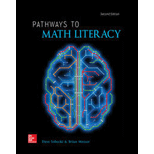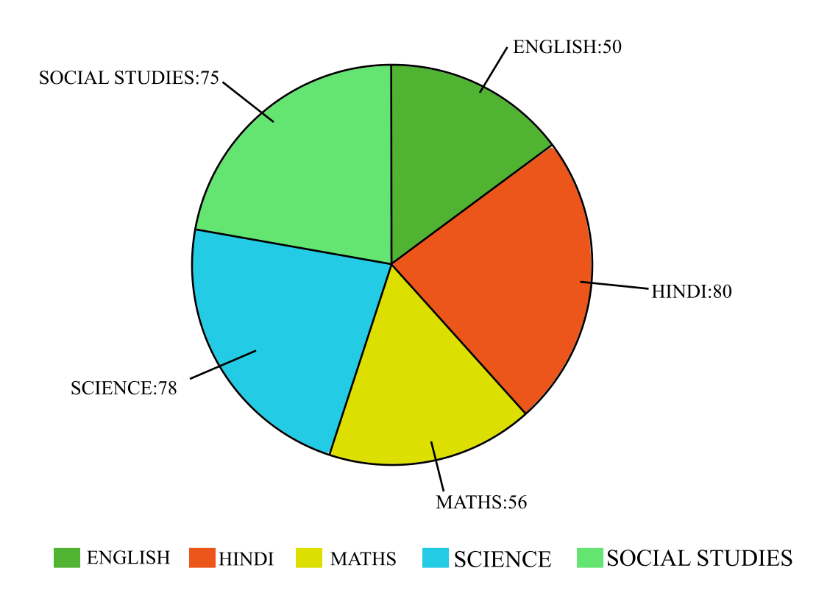
Concept explainers
Carefully read through the list of terminology we’ve used in this Unit. Consider circling the terms you aren’t familiar with and looking them up. Then test your understanding by using the list to fill in the appropriate blank in each sentence. Hint: One word is used twice.
axis
bar graph
categorical frequency distribution
classes
commutative
complement
compound interest
coordinates
data
degrees
element
empirical probability
exponential growth
grouped frequency distribution
histogram
interest
intersection
like quantities
linear growth
lower limit
origin
perimeter
pie chart
plotting points
population
probability
raw data
rectangular
representative sample
roster method
sample
scale
scientific notation
set
simple interest
stem and leaf plot
theoretical probability
time-series data
time-series graph
union
universal set
upper limit
Venn diagram
well-defined
x axis
y axis
A _______________ is a diagram used to compare the relative sizes of different parts of a whole.
To fill: The blank space in the provided statement, “A______ is a diagram used to compare the relative sizes of different parts of a whole”. By the use of provided list.
Answer to Problem 1LSR
Solution:
A pie chart is a diagram used to compare the relative sizes of different parts of a whole.
Explanation of Solution
Given information:
The provided list is below:
Explanation:
Consider the provided statement.
As it is known that the pie chart is a circle which is divided into a number of slices where each slice gives information about a particular data.
For example, the given pie chart representation of marks obtained by a student in different subjects- English, Hindi, Mathematics, Science and Social Science in an examination.

Therefore, the blank in the provided statement can be filled with the word pie chart.
Want to see more full solutions like this?
Chapter 1 Solutions
Pathways To Math Literacy (looseleaf)
Additional Math Textbook Solutions
College Algebra (Collegiate Math)
Intermediate Algebra (13th Edition)
Finite Mathematics for Business, Economics, Life Sciences and Social Sciences
Intro Stats, Books a la Carte Edition (5th Edition)
Precalculus: Mathematics for Calculus (Standalone Book)
- Answer this questionarrow_forwardIn this exercise, we will investigate a technique to prove that a language is notregular. This tool is called the pumping lemma.The pumping lemma says that if M = (S, I, f, s0, F ) is a DFA with p states (i.e., p = |S|) and if the wordw is in L(M ) (the language generated by M ) and w has length greater than or equal to p, then w may bedivided into three pieces, w = xyz, satisfying the following conditions:1. For each i ∈ N, xy^i z ∈ L(M ).2. |y| > 0 (i.e., y contains at least one character).3. |xy| ≤ p (i.e., the string xy has at most p characters). Use the pumping lemma to show the following language is not regular (HINT: Use proof by contradictionto assume the language is regular and apply the pumping lemma to the language):L = {0^k1^k | k ∈ N}arrow_forwardA prefix of length ℓ of some word w are the first ℓ characters (in order) of w.1. Construct a context-free grammar for the language: L = {w ∈ {a, b}∗ | every prefix of w has at least as many a’s as b’s}2. Explain why every word generated by your context-free grammar (in Part 1) is contained in L. Then,prove via induction that every w ∈ L is produced by your context-free grammar.arrow_forward
- Consider a simplified version of American football where on any possession ateam can earn 0, 3 or 7 points. What is the smallest number n0 of points such that for all n ≥ n0 and n ∈ Na team could earn n points. You must prove that your answer is correct via induction (HINT: Don’t forgetto show that n0 is the smallest number above which any number of points is reachable).arrow_forwardConsider a vocabulary consisting of the nucleotide bases V = {A, T, G, C}.Construct a DFA to recognize strings which end in AAGT .(a) Draw the DFA with clear markings of all states including start and acceptance state(s).(b) Simulate the DFA to show that string T GAAGT will be accepted by the DFA.(c) Simulate the DFA to show that string T AAGT G will not be accepted by the DFA.arrow_forwardA palindrome is a string that reads the same backward as it does forward. For example, abaaaba is a palindrome. Suppose that we need to define a language that generates palindromes.(a) Define a phase structure grammar that generates the set of all palindromes over the alphabet {a, b}clearly describing the recursive rules that generates palindromes. Use the notation Symbol → rule. Theempty set is denoted by λ. Clearly identify the terminal and non-terminal symbols in your grammar.(b) Show that the palindrome abaaaba can be recognized by your grammar. To show this, show all stepsof parsing the expression abaaaba using the rules you defined above.arrow_forward
- A full k-ary tree is a (rooted) tree whose nodes either have exactly k children (internal nodes) or have no children (leaves). Using structural induction, formally prove that every full k-ary tree that has x internal nodes has exactly kx + 1 nodes in total. Note that for full binary trees, i.e., when k = 2, this would imply that the total number of nodes is 2x + 1.arrow_forwardquestion 10 pleasearrow_forward00 (a) Starting with the geometric series Σ X^, find the sum of the series n = 0 00 Σηχη - 1, |x| < 1. n = 1 (b) Find the sum of each of the following series. 00 Σnx", n = 1 |x| < 1 (ii) n = 1 sin (c) Find the sum of each of the following series. (i) 00 Σn(n-1)x^, |x| <1 n = 2 (ii) 00 n = 2 n² - n 4n (iii) M8 n = 1 շոarrow_forward
- (a) Use differentiation to find a power series representation for 1 f(x) = (4 + x)²* f(x) = 00 Σ n = 0 What is the radius of convergence, R? R = (b) Use part (a) to find a power series for f(x) = 1 (4 + x)³° f(x) = 00 Σ n = 0 What is the radius of convergence, R? R = (c) Use part (b) to find a power series for f(x) = x² (4 + x)³* 00 f(x) = Σ n = 2 What is the radius of convergence, R? R = Need Help? Read It Watch It SUBMIT ANSWERarrow_forwardW AutoSave Off Soal Latihan Matdis (1) ▼ Search File Home Insert Draw Design Layout References Mailings Review View Help Aptos (Body) ✓ 12 A A Aa Ро Paste BI U ab x, x² A ✓ A ད Clipboard ₪ 24 23 22 21 20 19 18 17 16 15 1″ ידידיו Page 1 of 1 25°C 215 words Berawan E> M Font 四 Paragraph 3 4 1 56 ☑ 781 LI Comments Editing Find ✓ Normal No Spacing Heading Replace Add-ins Select Styles ☑ Editing Add-ins 91 10 111 12 | 13| 14 15 5. Suppose you wanted to draw a quadrilateral using the dots below as vertices (corners). The dots are spaced one unit apart horizontally and two units apart vertically. a) How many quadrilaterals are possible? b) How many are squares? How many are rectangles? c) How many are parallelograms? English (Indonesia) Accessibility: Investigate R - W ☑ Share ▾ Focus + 100% 00:17 13/04/2025arrow_forwardanswer for question 4 pleasearrow_forward
 Holt Mcdougal Larson Pre-algebra: Student Edition...AlgebraISBN:9780547587776Author:HOLT MCDOUGALPublisher:HOLT MCDOUGAL
Holt Mcdougal Larson Pre-algebra: Student Edition...AlgebraISBN:9780547587776Author:HOLT MCDOUGALPublisher:HOLT MCDOUGAL
 Functions and Change: A Modeling Approach to Coll...AlgebraISBN:9781337111348Author:Bruce Crauder, Benny Evans, Alan NoellPublisher:Cengage Learning
Functions and Change: A Modeling Approach to Coll...AlgebraISBN:9781337111348Author:Bruce Crauder, Benny Evans, Alan NoellPublisher:Cengage Learning Glencoe Algebra 1, Student Edition, 9780079039897...AlgebraISBN:9780079039897Author:CarterPublisher:McGraw Hill
Glencoe Algebra 1, Student Edition, 9780079039897...AlgebraISBN:9780079039897Author:CarterPublisher:McGraw Hill Elementary AlgebraAlgebraISBN:9780998625713Author:Lynn Marecek, MaryAnne Anthony-SmithPublisher:OpenStax - Rice University
Elementary AlgebraAlgebraISBN:9780998625713Author:Lynn Marecek, MaryAnne Anthony-SmithPublisher:OpenStax - Rice University Intermediate AlgebraAlgebraISBN:9781285195728Author:Jerome E. Kaufmann, Karen L. SchwittersPublisher:Cengage Learning
Intermediate AlgebraAlgebraISBN:9781285195728Author:Jerome E. Kaufmann, Karen L. SchwittersPublisher:Cengage Learning





